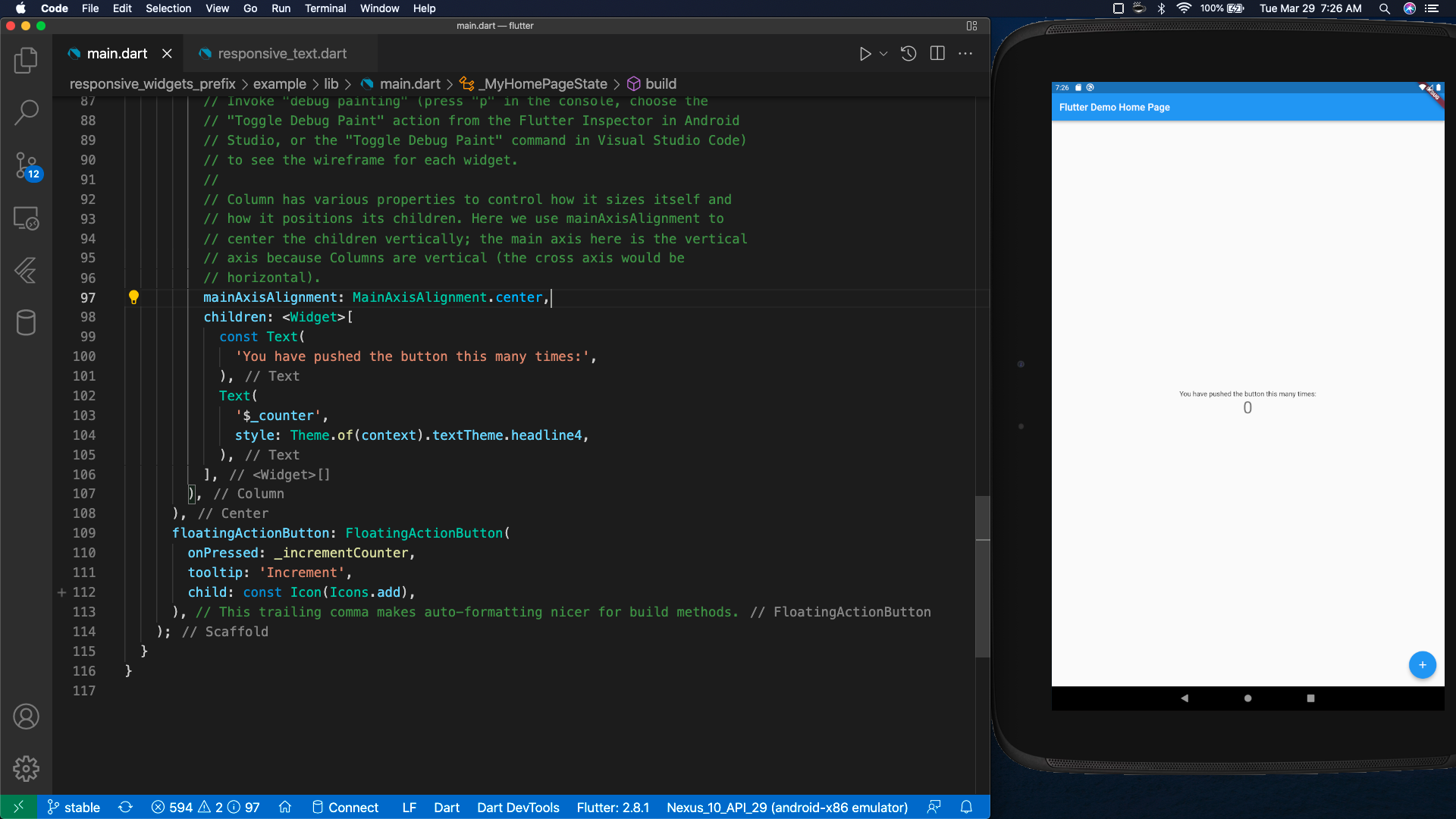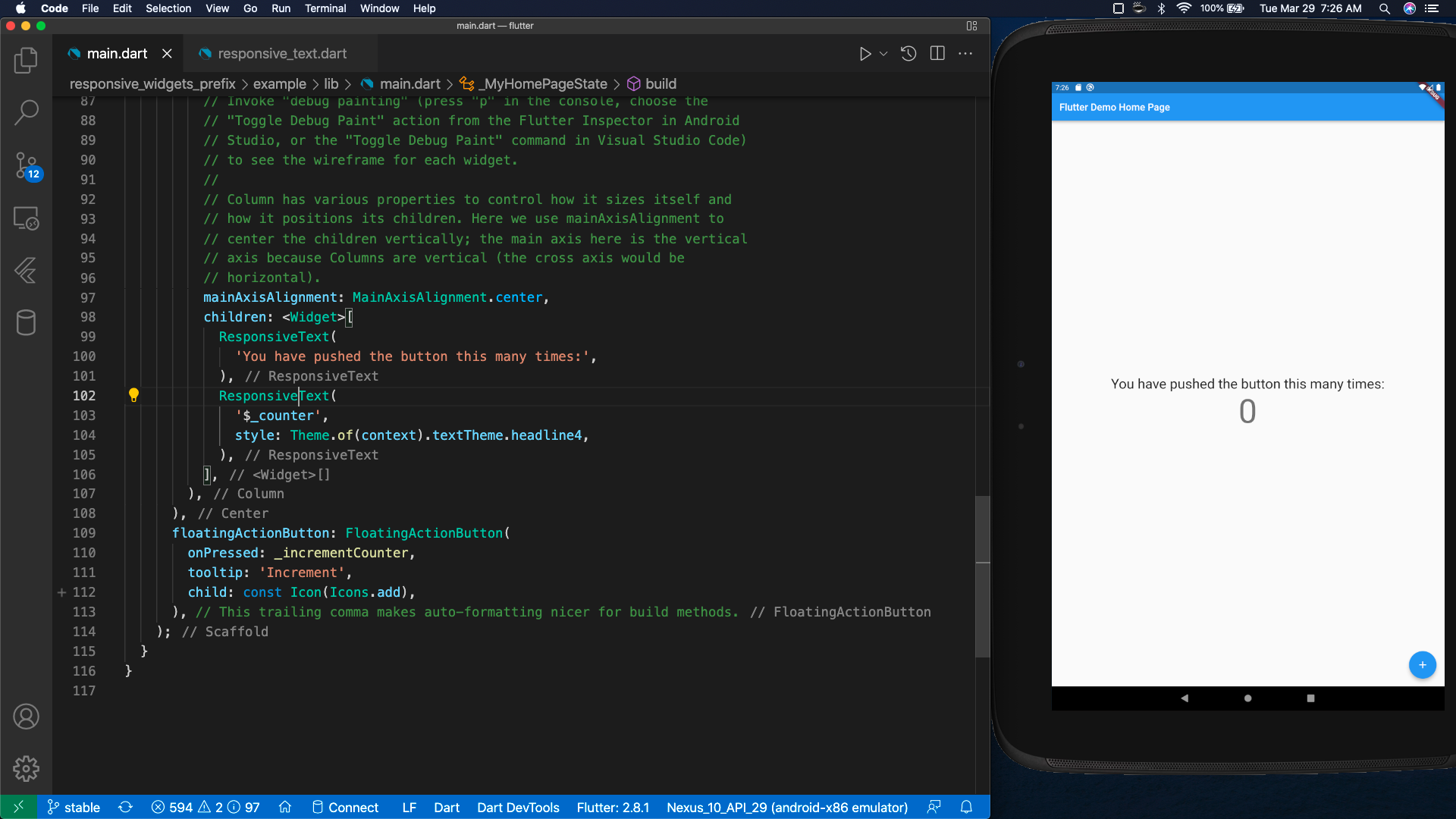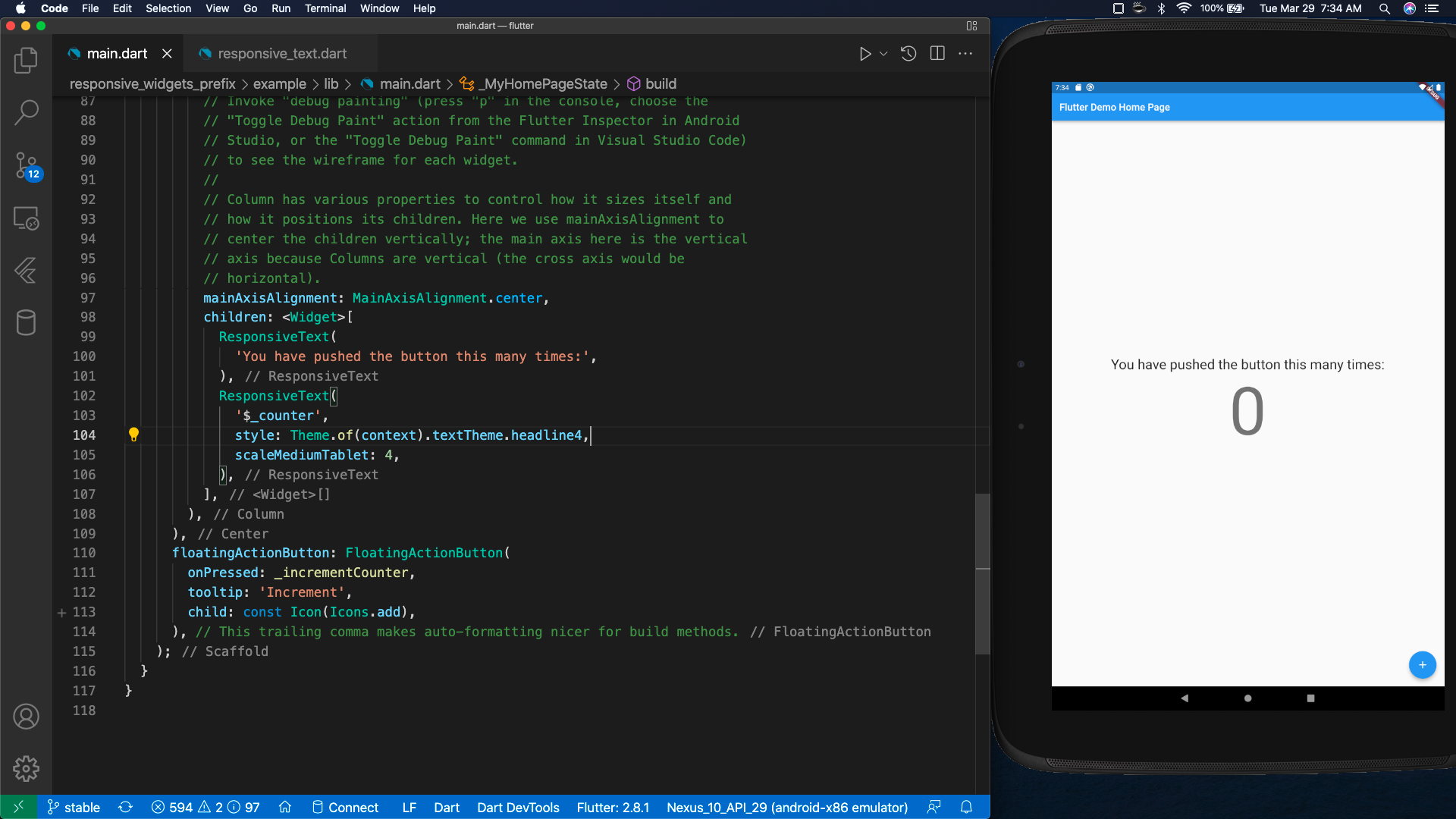Flutter响应式布局插件responsive_widgets_prefix的使用
Flutter响应式布局插件responsive_widgets_prefix的使用
插件介绍
responsive_widgets_prefix 是一个用于Flutter项目的插件,它允许开发者为任何需要根据设备屏幕大小进行缩放或字体大小调整的widget添加"Responsive"前缀。通过使用这个插件,可以更轻松地创建适应不同屏幕尺寸的应用界面。
功能特性
-
非响应式文本:在不使用响应式组件时,可能会遇到缩放问题。

children: <Widget>[ Text( 'You have pushed the button this many times:', ), Text( '$_counter', style: Theme.of(context).textTheme.headline4, ), ], -
默认的响应式文本:使用
ResponsiveText后,可以根据不同的屏幕尺寸自动调整大小,并且可以自定义缩放比例。
children: <Widget>[ ResponsiveText( 'You have pushed the button this many times:', ), ResponsiveText( '$_counter', style: Theme.of(context).textTheme.headline4, ), ], -
自定义响应式文本(针对中等平板电脑):例如,在iPad或其他类似的设备上,可以通过设置
scaleMediumTablet属性使计数器文字更大。
children: <Widget>[ ResponsiveText( 'You have pushed the button this many times:', ), ResponsiveText( '$_counter', style: Theme.of(context).textTheme.headline4, scaleMediumTablet: 4, ), ],
安装与配置
安装
方法一:直接安装
flutter pub get responsive_widgets_prefix
方法二:通过pubspec.yaml文件安装
编辑您的pubspec.yaml文件并添加依赖项:
dependencies:
flutter:
sdk: flutter
# 添加响应式组件库
responsive_widgets_prefix: ^latest_version
然后执行命令以获取新添加的包:
flutter pub get
导入
在Dart代码中导入响应式组件库:
import 'package:responsive_widgets_prefix/responsive_widgets_prefix.dart';
创建响应式应用
对于MaterialApp,只需简单地添加Responsive前缀即可:
return ResponsiveMaterialApp(
title: 'Flutter Demo',
theme: ThemeData(
primarySwatch: Colors.blue,
),
home: const MyHomePage(title: 'Flutter Demo Home Page'),
);
同样的方式适用于CupertinoApp:
return ResponsiveCupertinoApp(
title: 'Flutter Demo',
theme: CupertinoThemeData(
primaryColor: Colors.blue,
),
home: const MyHomePage(title: 'Flutter Demo Home Page'),
);
示例代码
下面是一个完整的示例应用程序,展示了如何结合responsive_widgets_prefix创建一个响应式的计数器应用。
import 'package:flutter/cupertino.dart';
import 'package:flutter/material.dart';
import 'package:responsive_widgets_prefix/responsive_widgets_prefix.dart';
void main() => runApp(setupMainWidget());
Widget setupMainWidget() {
WidgetsFlutterBinding.ensureInitialized();
return const MyApp();
}
class MyApp extends StatelessWidget {
const MyApp({Key? key}) : super(key: key);
@override
Widget build(BuildContext context) {
return PlatformApp(
defaultPlatform: PlatformWidget.platform,
androidApp: ResponsiveMaterialApp(
theme: ThemeData(primarySwatch: Colors.blue),
home: const MyHomePage(),
),
iosApp: ResponsiveCupertinoApp(
theme: const CupertinoThemeData(primaryColor: Colors.blue),
home: const MyHomePage(),
)
);
}
}
class MyHomePage extends StatefulWidget {
const MyHomePage({Key? key}) : super(key: key);
@override
State<MyHomePage> createState() => _MyHomePageState();
}
class _MyHomePageState extends State<MyHomePage> {
int _counter = 0;
void _incrementCounter() {
setState(() {
_counter++;
});
}
@override
Widget build(BuildContext context) {
return Scaffold(
appBar: AppBar(title: Text('Counter Sample')),
body: Center(
child: Column(
mainAxisAlignment: MainAxisAlignment.center,
children: <Widget>[
ResponsiveText('You have pushed the button this many times:'),
ResponsiveText('$_counter', style: Theme.of(context).textTheme.headline4, scaleMediumTablet: 4),
],
),
),
floatingActionButton: FloatingActionButton(
onPressed: _incrementCounter, tooltip: 'Increment', child: const Icon(Icons.add),
),
);
}
}
在这个例子中,我们创建了一个简单的计数器页面,并使用了ResponsiveText来确保文本能够根据屏幕尺寸适当地缩放。此外,还演示了如何在Android和iOS平台上分别使用ResponsiveMaterialApp和ResponsiveCupertinoApp。
希望这些信息对您有所帮助!如果您有任何其他问题或需要进一步的帮助,请随时提问。
更多关于Flutter响应式布局插件responsive_widgets_prefix的使用的实战系列教程也可以访问 https://www.itying.com/category-92-b0.html
更多关于Flutter响应式布局插件responsive_widgets_prefix的使用的实战系列教程也可以访问 https://www.itying.com/category-92-b0.html
当然,以下是如何在Flutter项目中使用responsive_widgets_prefix插件来实现响应式布局的代码示例。
首先,确保你已经在pubspec.yaml文件中添加了responsive_widgets_prefix依赖:
dependencies:
flutter:
sdk: flutter
responsive_widgets_prefix: ^最新版本号 # 请替换为实际的最新版本号
然后,运行flutter pub get来获取依赖。
接下来,在你的Flutter项目中,你可以使用ResponsiveWidgetsPrefix插件提供的响应式布局组件。以下是一个简单的示例,展示了如何使用这些组件来创建响应式UI。
import 'package:flutter/material.dart';
import 'package:responsive_widgets_prefix/responsive_widgets_prefix.dart';
void main() {
runApp(MyApp());
}
class MyApp extends StatelessWidget {
@override
Widget build(BuildContext context) {
return MaterialApp(
title: 'Responsive Layout Demo',
theme: ThemeData(
primarySwatch: Colors.blue,
),
home: ResponsiveScaffold(
appBar: AppBar(
title: Text('Responsive Layout Demo'),
),
body: ResponsiveWrapper.builder(
breakpoints: [
ResponsiveBreakpoint.desktop(1200),
ResponsiveBreakpoint.tablet(992),
ResponsiveBreakpoint.phone(576),
],
builder: (context, sizingInformation) {
return LayoutBuilder(builder: (context, constraints) {
// 根据屏幕尺寸调整布局
if (sizingInformation.deviceScreenType == DeviceScreenType.desktop) {
return _desktopLayout(constraints);
} else if (sizingInformation.deviceScreenType == DeviceScreenType.tablet) {
return _tabletLayout(constraints);
} else {
return _phoneLayout(constraints);
}
});
},
),
),
);
}
Widget _desktopLayout(BoxConstraints constraints) {
return Row(
children: [
Expanded(child: _sidebar()),
Expanded(
flex: 3,
child: _mainContent(),
),
],
);
}
Widget _tabletLayout(BoxConstraints constraints) {
return Column(
children: [
_header(),
Expanded(child: _mainContent()),
],
);
}
Widget _phoneLayout(BoxConstraints constraints) {
return Column(
children: [
_header(small: true),
Expanded(child: _mainContent(small: true)),
],
);
}
Widget _sidebar() {
return Container(
color: Colors.grey[300],
child: Padding(
padding: const EdgeInsets.all(16.0),
child: Text('Sidebar Content'),
),
);
}
Widget _header({bool small = false}) {
return Container(
color: Colors.blue[300],
height: small ? 60 : 100,
child: Center(child: Text('Header')),
);
}
Widget _mainContent({bool small = false}) {
return Container(
color: Colors.white,
padding: const EdgeInsets.all(16.0),
child: Text('Main Content'),
);
}
}
在这个示例中,我们使用了ResponsiveWrapper.builder来根据屏幕尺寸(桌面、平板、手机)动态调整布局。ResponsiveBreakpoint定义了不同屏幕尺寸的断点,sizingInformation.deviceScreenType用于判断当前设备的类型。
_desktopLayout函数定义了桌面布局,其中包含一个侧边栏和一个主要内容区域。_tabletLayout函数定义了平板布局,其中包含一个头部和一个主要内容区域。_phoneLayout函数定义了手机布局,其中包含一个较小的头部和一个主要内容区域。
你可以根据需要进一步自定义每个布局中的组件和样式。这个示例展示了如何使用responsive_widgets_prefix插件来实现基本的响应式布局。








